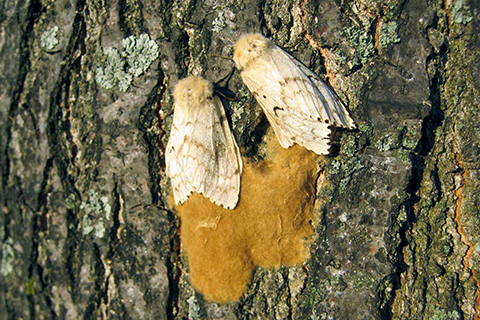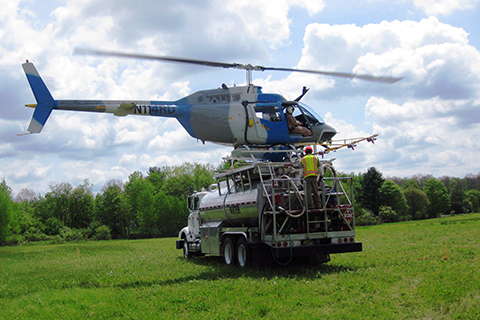There is no doubt that 2022 is an outbreak year for spongy moths (formerly known as gypsy moths), whose voracious caterpillars have stripped the leaf canopy in many areas of the state.
Spongy moths are known to target oaks, and many stands of oak have been hit hard in the state.
If you’ve noticed some barren mountaintops that seem to resemble more of a winter landscape than summer, unfortunately you are not alone. This is the unfortunate result of spongy moths.
When a tree is stripped of its leaves, it is known as defoliation. This weakens the tree as it uses up valuable resources to regrow leaves. It is important to note that it’s too early to tell if a recently defoliated tree from spongy moth will die.
It usually takes more than one defoliation event to kill a tree; however, a tree that was previously weakened by other factors could die from spongy moth defoliation.
Thankfully, defoliation from spongy moths this year is ending, as the caterpillar stage of development is nearly complete.
Egg Mass Surveying Part of Successful Treatment

The best time to plan for spongy moth treatment is not while the damage is actively occurring.
Successful treatment begins long in advance with egg mass surveying and planning during the preceding year.
Female spongy moths lay their eggs as light tan egg masses on trees, stones, and other flat sheltered areas during June and July.
Egg masses can range from the size of a quarter (200-250 eggs) to two to three inches long (more than 1,000 eggs).
Spongy moth eggs hatch from mid-April to early May the following spring.
You should survey your property for these egg masses in late summer and fall.
DCNR’s website provides information for removal of egg masses from individual yards and trees.
However, for larger forested properties, when egg mass surveys reveal that the spongy moth population has exceeded a certain threshold, aerial treatment is recommended for the following spring.
PennState Extension offers a Guide to Spongy Moth Egg Mass Surveying that can help you make a plan for your property. DCNR service foresters also can visit your property to provide information and advice.
Aerial Spraying for Spongy Moths

The best way to treat for spongy moths is by aerial spraying -- helicopter or fixed-wing aircraft -- targeting a specific stage in caterpillar development, so timing is critical to effectiveness.
If your forest area has been impacted heavily by spongy moth, you may wish to have your woodlot treated by professional pilots who use highly specialized equipment.
Counties, municipalities, and landowner/homeowner associations have the option of organizing aerial suppression programs to protect their trees from spongy moth damage.
It’s best to begin planning for aerial treatment during the winter months, so that treatments can begin in the spring (usually May) when 50 percent of the caterpillars are in their second phase.
DCNR does not spray for spongy moths on private lands; but does provide a Guide to Conducting a Private Spongy Moth Suppression Program (PDF) and a list of aerial applicators (PDF) who can help you determine what is best for your situation.
As caretakers of 70 percent of Penn’s Woods, private landowners can play an important role in helping to manage the spongy moth population.
What Has DCNR Done to Combat Spongy Moths?
.JPG)
This spring, DCNR’s Bureau of Forestry sprayed nearly 210,000 acres of state forest, state park, and national forest lands in Pennsylvania.
This total represents maximum capacity for the bureau, both logistically and in terms of budget.
The 2021 spongy moth spray program was nearly identical in size. A 2022 Spray Block Map shows the areas treated.
The Pennsylvania Game Commission also joined DCNR in the effort to control spongy moths by spraying more than 60,000 acres of state game lands. The U.S. Forest Service provided funding and support for spraying in the Allegheny National Forest.
In another positive development, DCNR’s Bureau of Forestry Division of Forest Health noticed a substantial uptick in private land spraying this year, demonstrating the power of the private sector in the total effort to control spongy moths.
Boom and Bust Cycle of Spongy Moths
Spongy moth populations follow a “boom and bust” cycle, where numbers are high for a period of years, followed by years of relatively low numbers.
The current outbreak will surely end at some point, but this can’t be forecast because important factors that affect their populations -- for example, seasonal weather -- are not known.
DCNR remains active and vigilant during this current outbreak, conducting egg mass surveys and aerial defoliation assessment flights, and planning next year’s spongy moth suppression program.
We encourage other forest landowners and managers, both public and private, to join us in the fight!